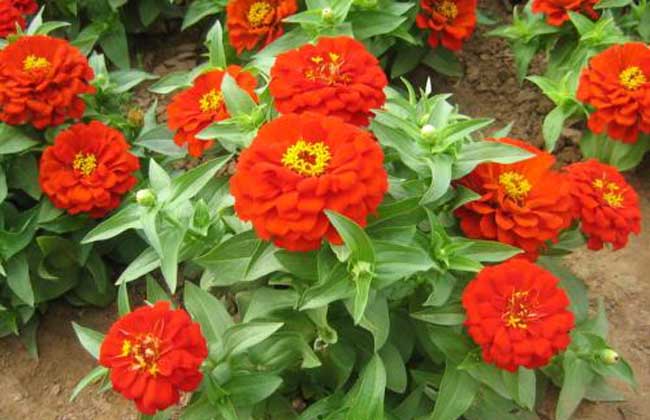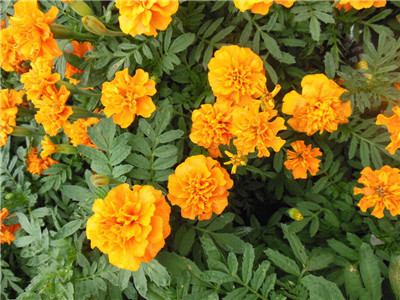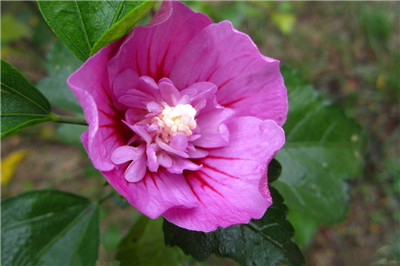The sowing method of zinnia seed
The optimum temperature for seed germination is 20-25 degrees, germinates in 7-10 days, and blossoms about 70 days after sowing. 2-3 true leaves were transferred and 5 hearts were removed from 4mur. they could be colonized after 2 or 3 times of transplantation.
In North China, it is more than sown in the open field in the middle or late of April, sprouting about a week, transplanting or interplanting when 2-3 true leaves are planted, and the row spacing of the plants in the field is set in the range of 15-40 cm due to the height of the varieties. When pot planting, it is necessary to pick the heart and transplant it to the pot, which can be inverted for one time. The dwarf species should repeatedly pick the heart, promote the growth of lateral branches and form plump plants. "May -" festival flowers can be sown indoors in early February. The seedlings were planted in the pot in late March and planted in the end of April. Topdressing is mainly phosphorus and potassium fertilizer.
Seed should be kept when the petals of the outer wheel begin to dry up and the petals of the middle wheel begin to fade, cut off the flower head, dry in the sun, and store. The flowering period of the hundred-day grass is long, and in the later stage, the plant will decline, the stems and leaves will be messy, and the flowers will become smaller. Therefore, the flowers used in the autumn flower bed should be re-sown in summer and pick the heart 1-2 times. Cutting propagation can be carried out after mid-June, cutting side wood cuttings, shading and rain protection.
Before sowing, the soil and seeds should be strictly disinfected to prevent diseases and insect pests during the growing period. The seeds can be sowed from early April to late June. The seeds are disinfected by soaking seeds with 1% potassium permanganate solution for 30 minutes, and the matrix is mixed with 2 parts of rotten leaf soil, 1 part of river sand, 2 parts of peat and 2 parts of perlite. Disinfect 0.5% potassium permanganate or 1000 times formaldehyde, and the soil can be fumigated at high temperature to kill germs, pests and grass species.
Sowing on demand after the substrate is wet before sowing, zinnia is a photophobic flower seed, and must be covered with vermiculite after sowing. At a temperature of 2123 degrees Celsius, it can germinate in 3 to 5 days, and no light is needed during the germination period. after germination, the seedling bed maintains 50%-60% water content, not too wet, so as to avoid rotting roots or quenching disease.

Seed selection
The seed life of zinnia is 3 years, and the germination rate is about 60%. Try to choose the full seeds of the previous year to improve the seed germination rate. When the petals of the outer wheel begin to dry up and the petals of the middle wheel begin to fade, cut off the flower head, dry it and store it.
Disinfection treatment
Before sowing, the soil and seeds should be strictly disinfected to prevent diseases and insect pests during the growing period. the seeds were soaked in 1% potassium permanganate solution for 30 minutes. The matrix is made of 2 parts of rotten leaf soil, 1 part of river sand, 2 parts of peat and 2 parts of perlite, which can be disinfected with 0.05% potassium permanganate or 1000 times formaldehyde, and the soil can be fumigated at high temperature to kill germs, pests and grass seeds.
Sowing time
The sowing time of hundred-day grass depends on the required flowering time, generally sowing in the greenhouse 2-3 months in advance, direct seeding in the open field should be after the severe cold in early spring, otherwise the seedlings are underdeveloped. If the flower bed is used in autumn, it is suitable to sow in summer, spring sowing in March to April, transplanting in 4 to 5 leaves, planting in early June, and flowering from July to Frosts Descent.
Sowing method
Zinnia seeds can be sowed on demand or withdrawn, because they are photophobic flower seeds, they must be covered with vermiculite after sowing, and they can germinate in 3 to 5 days at 21: 23 ℃. There is no need for light during the germination period. After germination, the seedling bed should keep 50% of the water content, not too wet, so as to avoid rotting roots or sudden falling disease.
Seedling management
After the seedlings of zinnia grow out of a true leaf, the seedlings are transplanted once, the root system of zinnia is undeveloped, and the lateral roots are less. Generally, when transplanting 2 true leaves, it should be planted in a pot, and the transplanting substrate should be loose, fertile and well drained. It can be prepared with 3 parts of pond mud, 1 part of rotten leaf soil and 1 part of mature heap manure, and the planting depth is 0.5 cm under cotyledons. After planting, the soil is lightly pressed and watered.
The best month to sow zinnia seeds, the planting method of zinnia / planting from April to June
Among the breeding methods of zinnia, sowing and reproduction is a more commonly used method, and the survival rate is relatively high, but if you want to plant successfully, there are many things you need to pay attention to. When is the best month to sow seeds? What are the planting methods of zinzhiju? Next, the editor will take you to learn about it.
First, zinnia seeds are best sown in which month, from April to June
When we sow and breed the hundred-day chrysanthemum, it is very important to choose the right time to sow the hundred-day chrysanthemum. When it comes to sowing the hundred-day chrysanthemum, we can choose from early April to late June. Because the climate at this time is more suitable for its growth, so the survival rate will be relatively higher.
Second, the planting method of zinzhiju
1. Matrix, good drainage.
Before we plant a hundred-day chrysanthemum, we must first choose the substrate, which is a step to lay a good foundation, so we must choose a suitable one. Hundred-day chrysanthemum prefer loose and fertile sandy soil, which has good drainage and air permeability, which can better absorb nutrients and is not prone to stagnant water.
two。 Disinfection, medicament sterilization
We also need to disinfect the substrate and seeds before we propagate the seeds. We can soak the seeds with 1% potassium permanganate solution for 30 minutes to disinfect the seeds, while we can disinfect the matrix with 0.05% potassium permanganate or 1000 times formaldehyde, or we can use high temperature fumigation to kill germs, pests and grass seeds.
3. To soak in warm water.
After we have sterilized the seeds and substrates, we also need to soak the seeds in warm water for one day, and then take them out when they begin to absorb water and swell, which can play a role in promoting the germination of zinnia seeds. can improve its germination rate and germination speed.
4. Plant and sprout in 3-5 days
Before sowing, we first need to apply an appropriate amount of base fertilizer in the soil, then spread the sterilized seeds evenly on the soil surface, and then cover it with 1-2cm soil. After sowing, we should control the temperature between 21-23 ℃ and put it in half-shade, and then germinate in 3-5 days.
5. Follow-up, temperature control
When the seedlings of zinnia grow 2 leaves and 5-8cm high, we can transplant it once. It takes 45-60 days from planting to flowering due to different varieties, and the optimum temperature for its growth is 15-30 ℃. It needs sufficient sunlight except for the seedlings to be sheltered from the sun and rain. Planting the upper basin can use loose, fertile and well-drained sandy soil.
- Prev

How to grow zinnia?
Some flower friends want to raise hundred-day grass, but do not know how to grow it. In this paper, from the point of view of flower friends, starting from the most basic sowing of hundred-day grass, so that flower friends can have a detailed impression of how to plant hundred-day grass. This article is aimed at flower lovers. Non-large area zinnia planting
- Next

How to breed hibiscus
The propagation methods of Hibiscus chinensis are sowing, layering, cuttage and plant division, but cutting propagation and plant division propagation are mainly used in production. Cuttings propagation Cuttings are easier to survive, some even use long branches, but the depth of the soil must be at least 20 cm, otherwise easy to lodge or sprout after the root is shallow and vulnerable to drought; general spring cuttings
Related
- Fuxing push coffee new agricultural production and marketing class: lack of small-scale processing plants
- Jujube rice field leisure farm deep ploughing Yilan for five years to create a space for organic food and play
- Nongyu Farm-A trial of organic papaya for brave women with advanced technology
- Four points for attention in the prevention and control of diseases and insect pests of edible fungi
- How to add nutrient solution to Edible Fungi
- Is there any good way to control edible fungus mites?
- Open Inoculation Technology of Edible Fungi
- Is there any clever way to use fertilizer for edible fungus in winter?
- What agents are used to kill the pathogens of edible fungi in the mushroom shed?
- Rapid drying of Edible Fungi

